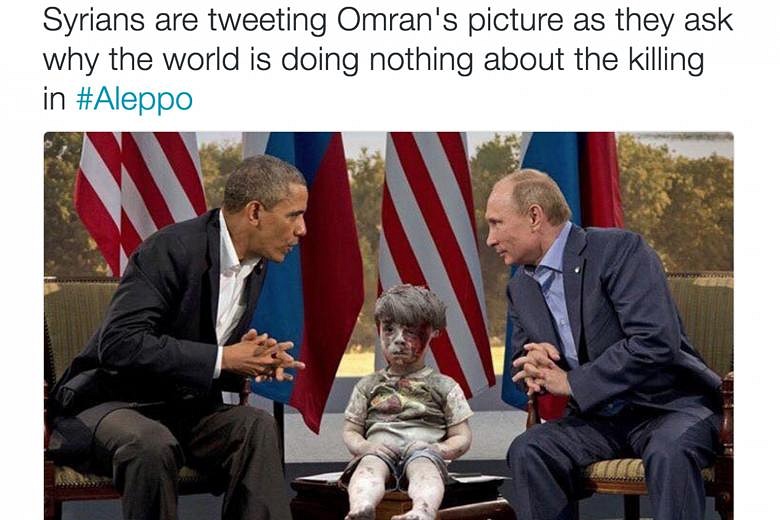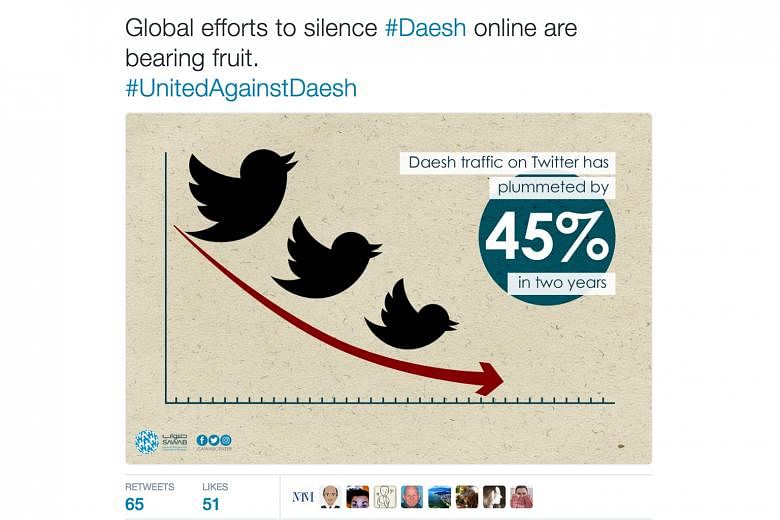"This is Omran. He's alive. We wanted you to know," said CNN anchor Kate Bolduan in a quivering voice while holding back tears.
The video she is referring to is one that has sparked a social media frenzy this past week.
Shot in Aleppo, Syria, it shows a young boy being rescued from the rubble that was his home, after it was destroyed in an air strike.
Omran Daqneesh, five, looks shell-shocked as he sits eerily still on an orange chair in an ambulance.
While waiting for medical attention, he wipes the left side of his bloodied face. When he sees his hand caked with blood, he instinctively, in a heart-wrenching fashion, tries to rub it off on the side of the seat.
 A picture tweeted by journalist Raf Sanchez, with a superimposed Omran between Mr Obama and Mr Putin, is one of the many images that netizens are sharing to bring more attention to the ongoing Syrian crisis. PHOTO: RAF SANCHEZ/TWITTER
A picture tweeted by journalist Raf Sanchez, with a superimposed Omran between Mr Obama and Mr Putin, is one of the many images that netizens are sharing to bring more attention to the ongoing Syrian crisis. PHOTO: RAF SANCHEZ/TWITTER
-
NOTABLE TRENDS
-
JOSEPH SCHOOLING: Without a doubt, the 21-year-old gold-medal winner at the Olympics has dominated the local social media space this past week. Many news outlets, including The Straits Times, leveraged on live-streaming features to bring readers close to the action.
POKEMON GO: It is a game that has united old friends, strangers, the old and the young as players search for elusive Snorlaxes and Dragonites. Pokemon fatigue has yet to set in here, as it has in other countries, but in the meantime, do be considerate.
LEE CHONG WEI: The Malaysian badminton legend's win over his arch-rival, China's Lin Dan, lit up social media. Google Trends shows searches for his name peaked on Friday night, with more than 50,000 look-ups.
The calmness, observers say, is because the child is in a state of extreme shock.
The video has been touted as a vivid reminder of the horror that continues day after day amid the Syrian crisis.
As of Friday evening, it had been viewed almost 16 million times.
Ms Bolduan's clip is one of many that have seized upon the visceral imagery to drive home the suffering endured by Syrian residents and refugees.
As violence escalates around the globe, it is increasingly common for netizens to be desensitised to the attacks that seem to occur on a daily basis.
In fact, so commonplace are these onslaughts that readers will only sit up and notice if casualties number in the hundreds, or if people or places that are deemed important make the headlines.
A common complaint many people have is that the media is biased towards attacks in the Western world.
A life is a life - so why are attacks in, say, Paris or London given more substantial airplay on news channels?
But through social media, Omran's story has managed to generate some much-needed buzz, and hopefully, will galvanise people into action.
A tweet by Mr Raf Sanchez, a Telegraph correspondent in the Middle East, has given many netizens food for thought.
It shows US President Barack Obama engaged in a serious discussion with Russian President Vladimir Putin.
Superimposed in the middle sits Omran in his dust-caked hair, blank expression and bloodied Nickelodeon T-shirt.
"Syrians are tweeting Omran's picture as they ask why the world is doing nothing about the killing in #Aleppo," the caption reads.
Another thought-provoking image, this time by illustrator Khalid Albaih, shows the harsh realities Syrian children face.
It shows Omran seated on the left, juxtaposed with Aylan Kurdi, the three-year-old Syrian boy whose dead body was found washed up on a beach in Turkey.
These are the choices for the children, says Al Arabiya news channel senior anchor Rima Maktabi, who retweeted the image. "There are other choices for #Syrian kids. Safety is one of them, but only if the world chooses to help!" she added.
A Poynter article, written by author Kenneth Irby in September last year, offers some insights into why such images impact people more than, say, a mass of victims in the aftermath of an attack.
"In most cultures, children are valued as precious gifts of life - treasured icons of hope," he says. "When children are harmed, abused or neglected, the world gasps collectively - sometimes mobilising to action."
One memorable example occurred on June 8, 1972. Vietnamese children were depicted fleeing from a napalm bombing. The focus of the photo was a naked nine-year-old girl.
The iconic image has been credited for playing a huge role in ending the war.
For many of these children, escape is an option fraught with peril and, in many instances, one that leads to fatal consequences.
Thankfully, as we later find out, Omran and his immediate family - his parents, as well as his brother and sister - survived the bombing.
But many others, sadly, do not.
THE SOCIAL MEDIA BATTLE AGAINST INCITEMENT

It's no secret that social media has been instrumental in the spread of radicalisation.
Social media giants Facebook and Twitter are facing an uphill task in making sure that malicious content is contained and, at the same time, ensuring that they do not appear too draconian in their methods.
According to a report last week, Facebook took down the social media accounts of several leading members of the organisation Hamas apparently for promoting violence.
The leading platform reportedly also shut down the accounts of Palestinian Islamic Jihad leaders.
This has attracted both plaudits and criticisms.
Similarly, Twitter has suspended 360,000 pro-terrorism accounts since mid-2015, it said in a blog post on Thursday.
"We remain committed to eliminating the promotion of violence or terrorism on our platform," it said.
"There is no one 'magic algorithm' for identifying terrorist content on the Internet," it added, "But we continue to utilise other forms of technology, like proprietary spam-fighting tools, to supplement reports from our users and help identify repeat account abuse."
With about a third of the world's population of 7.4 billion active on social media, such moves have been lauded by many observers as a step in the right direction.
But it would be unreasonable, not to mention unrealistic, for users to entrust such an important task purely to the technology companies who, among the other things they worry about, have to grow their user base for their shareholders.
Bearing that in mind, the onus is on us - social media users - to make sure we remain vigilant in both thoughts and tweets.



